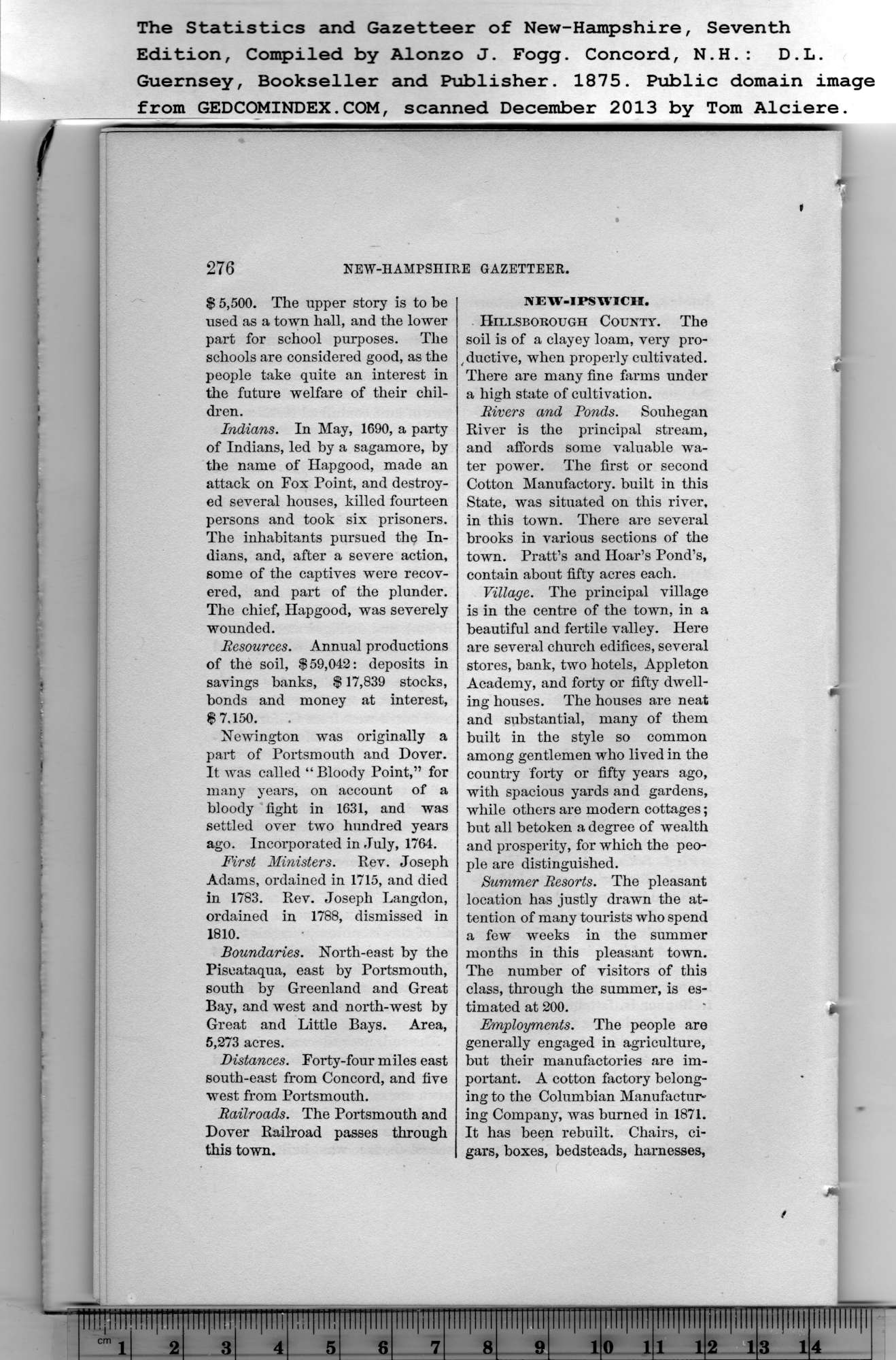|
276
The Statistics and Gazetteer of New-Hampshire, Seventh
Edition, Compiled by Alonzo J. Fogg. Concord, N.H.: D.L.
$ 5,500. The upper story is to be
used as a town hall, and the lower
part for school purposes. Tlie
schools are considered good, as the
people take quite an interest in
the future welfare of their chil-
dren.
Indians. In May, 1690, a party
of Indians, led by a sagamore, by
the name of Hapgood, made an
attack on Fox Point, and destroy-
ed several houses, killed fourteen
persons and took six prisoners.
The inhabitants pursued the In-
dians, and, after a severe action,
some of the captives were recov-
ered, and part of the plunder.
The chief, Hapgood, was severely
wounded.
Resources. Annual productions
of the soil, $59,042: deposits in
savings hanks, $ 17,839 stocks,
bonds and money at interest,
$7,150.
Newington was originally a
part of Portsmouth and Dover.
It was called “Bloody Point,” for
many years, on account of a
bloody fight in 1631, and was
settled over two hundred years
ago. Incorporated in July, 1764.
First Ministers. Rev. Joseph
Adams, ordained in 1715, and died
in 1783. Rev. Joseph Langdon,
ordained in 1788, dismissed in
1810.
Boundaries. North-east by the
Piseataqua, east by Portsmouth,
south by Greenland and Great
Bay, and west and north-west by
Great and Little Bays. Area,
5,273 acres.
Distances. Forty-four miles east
south-east from Concord, and five
west from Portsmouth.
Railroads. The Portsmouth and
Dover Railroad passes through
this town. |
NEW-IPSWICH.
Hillsborough Coukty. The
soil is of a clayey loam, very pro-
ductive, when properly cultivated.
There are many fine farms under
a high state of cultivation.
Rivers and Ponds. Souhegan
River is the principal stream,
and affords some valuable wa-
ter power. The first or second
Cotton Manufactory, built in this
State, was situated on this river,
in this town. There are several
brooks in various sections of the
town. Pratt’s and Hoar’s Pond’s,
contain about fifty acres each.
Village. The principal village
is in the centre of the town, in a
beautiful and fertile valley. Here
are several church edifices, several
stores, bank, two hotels, Appleton
Academy, and forty or fifty dwell-
ing houses. The houses are neat
and substantial, many of them
built in the style so common
among gentlemen who lived in the
country forty or fifty years ago,
with spacious yards and gardens,
while others are modern cottages;
but all betoken a degree of wealth
and prosperity, for which the peo-
ple are distinguished.
Summer Resorts. The pleasant
location has justly drawn the at-
tention of many tourists who spend
a few weeks in the summer
months in this pleasant town.
The number of visitors of this
class, through the summer, is es-
timated at 200.
Employments. The people are
generally engaged in agriculture,
but their manufactories are im-
portant. A cotton factory belong-
ing to the Columbian Manufactur-
ing Company, was burned in 1871.
It has been rebuilt. Chairs, ci-
gars, boxes, bedsteads, harnesses, |
